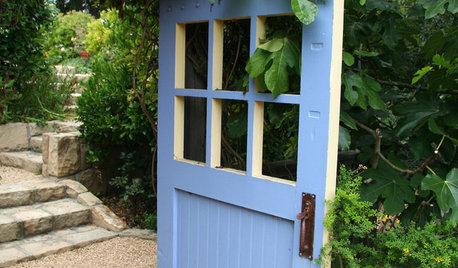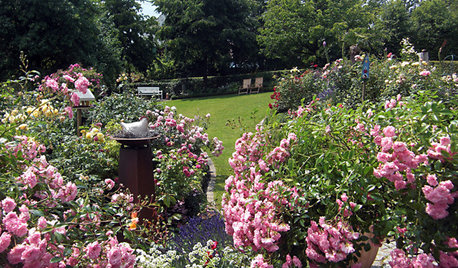Climbing old roses with fenced veg garden - need help designing
carol6ma_7ari
14 years ago
Featured Answer
Sort by:Oldest
Comments (20)
hoovb zone 9 sunset 23
14 years agolast modified: 9 years agomad_gallica (z5 Eastern NY)
14 years agolast modified: 9 years agoRelated Discussions
Help-Designing a Children's Garden and need some enchanting ideas
Comments (6)Begin by mapping on paper the usage of the back yard, including any natural pathways. Think carefully about sun exposure and how you can use it to your best advantage, and the areas where you need to control the exposure. Hardscape should come first, with materials that mix well with your house materials, style, and colors. Budget and practicality are important. Your two year old twins will go through many childhood phases rather quickly, and your garden is small, so it makes sense to use an adaptable scheme and limit the number of segregated areas. My own kids had a paved area, a grass area, a dirt area, and a non-traditional "playhouse/fort" area built under an existing patio cover. This allowed for a multitude of play activities only limited by their imaginations. We had a planting area in the sunniest spot where I grew giant sunflowers and tomatoes, nothing fancy. When they were little we were on the go all the time, and actual gardening was a fairly low priority. To summarize: children are easy to please....See MoreDesign for a climbing rose....
Comments (6)We did exactly this to train our ramblers onto our 4-board pasture fence. All of ours are trained as horizontally as they'll go. The canes of Leontine Gervais and Francois Juranville, which are very flexible, are parallel to the ground. Albertine is much stiffer, so it's more of a fan shape. We used galvanized electric fence wire. It's available at any farm supply store, and it's not expensive at all. A roll of 1/4 mile was about $13, if I remember correctly. We stapled it to the fence posts with a pneumatic stapler and 1" staples. You could also use electrical cable staples, if you want to hammer it by hand. Our wires are about a foot apart, because we have a wire between each board of the fence. If I were to do it from scratch, I'd probably space them every 8" or so. You can tie the rose to the wire using jute twine or pieces of panty hose. The jute will rot as the rose grows, so it won't strangle. The panty hose is very flexible ... same result. The tie needs to expand as the rose grows. (I have dozens and dozens of climbers and ramblers, so I use a vineyard tool that staples the roses to the wire with green tape ... my husband gives the BEST birthday presents.) Here's a picture of a few of mine. (Alberic Barbier, Francois Juranville, and Aviateur Bleriot) Connie...See MoreLarge cul-de-sac backyard, desperate need of rose garden design
Comments (20)Sorry, I hit the Submit button by mistake. As you can see mine has evolved since the initial inspiration and every part was an incredible amount of work and exertion, and though roses have moved and left, companion plants have grown and left, and now evergreen azaleas have been added to give naked canes some cover and a more filled look to the beds, I've always been happy with the circle design. It was the exhilarating first step. As far as digging in the sun, in my first backyard rose bed I actually used a beach umbrella for shade while I sat on the ground with my feet dangling in the bed doing the "double dig" because it was killing my back to bend that far over to dig the second shovel down. Have you ever tried digging from a seated position? It works. Also you need a wheelbarrow and probably a wagon with big rubber tires for hauling bags and bricks and all the other stuff you need for maintenance, feeding, etc. You need to learn how to best spend your strength and energy. Don't go wasting it on lugging 40 lb bags of compost one at a time. Pulling a heavy cart with 4 bags on it is easier on your back that carrying one bag from the front yard to the back 150 times. Better yet, will your vehicle fit into the backyard? Got some friends? I'm excited for you to be starting your wonderful garden, and I'm so glad that part is behind me. Work smart and protect yourself. Also, I think you'll find the most success with Teas, Chinas and Noisettes. They love our heat, don't mind humidity & wet weather and don't suffer from the fungal diseases that modern roses do. Since I don't spray, that's very important. Where are your photos??? Hartwood, I love your gardens, designs and roses. I wish I could get to Virginia to see them in person. You've done such a beautiful job. Sherry...See MoreClimbing roses for fence
Comments (40)You mentioned you were considering Lady of Shalott. Here is my experience after several years growing. Many of her canes are flexible not strong like Quick or Crush. They do toughen up as they age but it takes a while for mine. This was taken at 1:30 today in our heat. It opened this morning. This is a bloom that opened yesterday afternoon, taken at 1:30 today Also taken at 1:30. Center flower will look this way by late afternoon today or late tomorrow morning. By the end of day this bloom will be ugly brownish but the petals will not drop cleanly. What I have discovered is that L of S will put out lots of flowers to compensate for lack of staying power but only if you flood her with water. The Lady seems to be a heavy drinker. Mine looks especially nice from a distance because color shows up. If you do not have the time to clip dead flowers she starts to look a bit trashy with all those brown ones hanging about. Wonder how the Quicks and Lav Crush would look on your fence mixed with a couple the Shalotts for contrast. Not the soft pink you were wanting however....See Morecarolinamary
14 years agolast modified: 9 years agoelemire
14 years agolast modified: 9 years agocarol6ma_7ari
14 years agolast modified: 9 years agoyork_rose
14 years agolast modified: 9 years agomad_gallica (z5 Eastern NY)
14 years agolast modified: 9 years agocarol6ma_7ari
14 years agolast modified: 9 years agomendocino_rose
14 years agolast modified: 9 years agocarol6ma_7ari
14 years agolast modified: 9 years agocarolinamary
14 years agolast modified: 9 years agocarol6ma_7ari
14 years agolast modified: 9 years agoelemire
14 years agolast modified: 9 years agocarolinamary
14 years agolast modified: 9 years agoyork_rose
14 years agolast modified: 9 years agomad_gallica (z5 Eastern NY)
14 years agolast modified: 9 years agomarcy3459
14 years agolast modified: 9 years agocarolinamary
14 years agolast modified: 9 years agocarol6ma_7ari
14 years agolast modified: 9 years ago
Related Stories

GARDENING GUIDESGreat Design Plant: Knock Out Roses
As glorious as their high-maintenance kin for a fraction of the work, Knock Out roses make even beginners look like garden stars
Full Story
PETS6 Ways to Help Your Dog and Landscape Play Nicely Together
Keep your prized plantings intact and your dog happy too, with this wisdom from an expert gardener and dog guardian
Full Story
PLANTING IDEASGreat Garden Combo: Rose + Clematis for Small-Space Impact
We all need somebody to lean on. And when a rose supports a climbing vine, the results can totally transform a small garden
Full Story
LANDSCAPE DESIGNArtful Salvage: Old Doors Decorate the Garden
In a fence or leading only to imagination, salvaged doors can create lots of intrigue for little cash
Full Story
GARDENING GUIDESWhat Kind of Roses Should You Grow?
Want to add the beauty of roses to your garden? Find out which ones, from old-fashioned to modern, are right for you
Full Story
FARM YOUR YARDThe 8 Tools That Help Bring the Farm to Your Table
Vegetable gardeners get a big assist from these essential helpers
Full Story
GARDENING GUIDESRoses: Crowning Touch of Gardens
Whether you're the Miss or Mister America of gardening or take a hands-off approach, roses can be a winning addition to your landscape
Full Story
WINTER GARDENINGPruning Secrets for Exquisite Roses
Encourage gorgeous blooms year after year with this time-tested advice on how to prune your rosebush in winter for health and shape
Full Story
GARDENING GUIDES6 Captivating Roses for an Alluringly Fragrant Garden
Perfume your garden with aromas from richly spicy to lightly sweet, without sacrificing an inch of color
Full Story
GARDENING GUIDES5 Sweet to Spirited Pink Roses for an Enchanting Garden
Whether you go demure or daring, there's a pink rose here to make you flush with garden pride
Full Story







catsrose